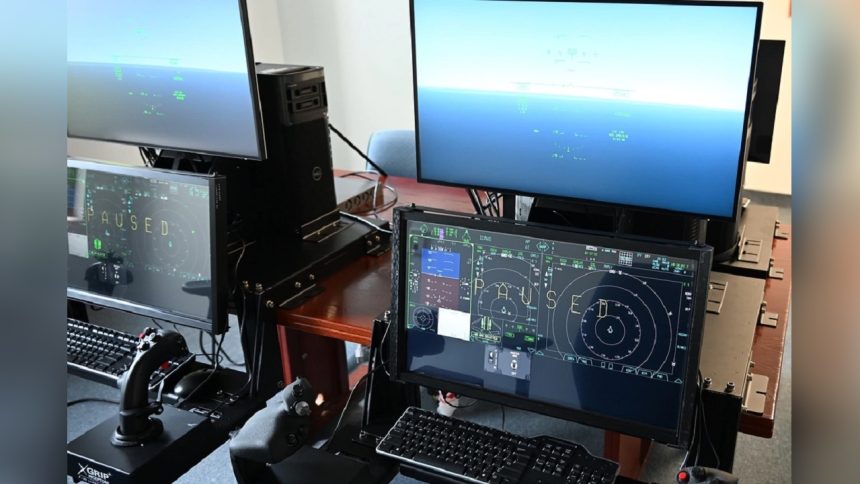USS Abraham Lincoln deployed with the new Simulators at Sea developed by NAWCAD to allow the Carrier Air Wing to continue training as a joint fighting force while deployed.
The USS Abraham Lincoln (CVN-72) aircraft carrier recently deployed with a new training tool aboard, which provides its aviators with new advanced training capabilities. This first-of-its-kind training capability is called Simulators at Sea and was developed and installed by the Naval Air Warfare Center Aircraft Division (NAWCAD). It features connected desktop trainers that allow pilots to practice missions together while deployed at sea, a historically limited capability.
“Simulators at Sea brings American aviators a level of readiness our carrier air wing has never experienced while deployed,” said NAWCAD Commander Rear Adm. John Dougherty IV. “This training is a game changing advantage that keeps our forces the most dominant in the skies.”
Simulators at Sea, available since July 2024, was developed for USS Abraham Lincoln in less than 12 months, following a previous deployment of F-35 simulators aboard USS Carl Vinson (CVN-70) in 2023.
Now pilots of Carrier Air Wing Nine (CVW-9), flying F-35C Lightning II stealth multirole fighters, F/A-18E/F Super Hornet multirole fighters, EA-18G Growler electronic warfare aircraft and E-2D Hawkeyes airborne early warning (AEW) planes are the first to be able to rehearse joint missions while deployed at sea.
The possibility to train on a simulator is a great opportunity, providing aviators with a less expensive alternative to real exercises, without the inherent risks of airborne operations, independent of weather conditions and negating intelligence gathering on tactics and procedures to adversaries. These problems previously significantly limited joint mission training aboard deployed aircraft carriers.
Abraham Lincoln Carrier Strike Group has heard the call! 📞 #LincolnNation answers the Nation’s call. 💪 😎
Carrier Air Wing 9 consists of eight squadrons including @USMC F-35C Lightning II aircraft assigned to Marine Fighter Attack Squadron (VMFA) 314. #BlueGreenTeam pic.twitter.com/dYZKnu53rf
— USS Abraham Lincoln (@CVN_72) August 12, 2024
NAWCAD
Simulators at Sea is just the latest addition to NAWCAD’s training portfolio. The Naval Air Warfare Center Aircraft Division, which employs more than 17,000 military, civilian and contract personnel, manages both testing and training of the Joint Simulation Environment (JSE) at its main base at Naval Station Patuxent River, Maryland.
Originally started with only F-35 simulators, JSE was later expanded to add Air Force F-22 Raptor cockpits in January 2024. The system now has eight F-35 cockpits and domes, four F-22 Raptors and four adversary cockpits, serving the Air Force, the Navy and the Marine Corps, as well as international partners.
Missions at JSE generally run between 30-45 minutes with full briefings and debriefings and the facility is fully booked for training for the foreseeable future. NAWCAD is also set to further expand the JSE program.
Additional F-18E/F Super Hornet and E-2D Hawkeye cockpits are expected to join the facility, while F-35 cockpits will be available at Nellis Air Force Base or at Naval Air Station Fallon (Nevada) and Edwards Air Force Base (California).
The “lite” version of JSE, Simulators at Sea, is instead available on USS Carl Vinson (CVN-70) and now also on USS Abraham Lincoln (CVN-72).
“Naval aviators train extensively working up to deployment, but those skills begin to atrophy the day they pull out of port,” said NAWCAD Joint Simulation Environment Director Blaine Summers, whose team delivered the Simulators at Sea capability. “This was a capability gap we had to plug with a fully integrated carrier air wing solution—one we’re ready to scale across the Navy’s fleet of carriers.”
USS Abraham Lincoln
With the new Simulators at Sea onboard, USS Abraham Lincoln has just arrived in the CENTCOM (Central Command) area of responsibility. The carrier received orders to accelerate the transit from the Indo-Pacific to the Middle East as the U.S.A. move more assets to the area, following the elimination of Hamas leader Ismail Haniyeh in Teheran and of Hezbollah leader Fuad Shukr in Beirut last month, which sparked new tensions.
Amid threats of Iranian attacks against American and Israeli forces, USS Lincoln is set to join the U.S.-led Operation Prosperity Guardian effort to protect merchant shipping in the region (particularly from Houthi attacks from Yemen) and to relieve USS Theodore Roosevelt (CVN-71), which has been operating in support of Prosperity Guardian since June after itself relieving USS Dwight D. Eisenhower (CVN-69).
USS Abraham Lincoln (CVN-72) operates with the embarked Carrier Air Wing 9, comprising two squadrons of F/A-18E Super Hornets (VFA-14 and VFA-151), one squadron of F/A-18F Super Hornets (VFA-41), one squadron of F-35C Lightning IIs (VMFA-314 “Black Knights”), one squadron of EA-18G Growlers (VAQ-133), one squadron of E-2D Hawkeyes (VAW-117) and additional C-2A carrier onboard delivery (COD) from VRC-40 and MH-60 helicopters from HSM-71 and HSC-14. The carrier group is also escorted by three Arleigh Burke-class Destroyers, USS Frank Petersen Jr. (DDG-121), USS Spruance (DDG-111) and USS O’Kane (DDG-77).
USS Abraham Lincoln (CVN 72), equipped with F-35C and F/A-18 Block III fighters, entered the U.S. Central Command (USCENTCOM) area of responsibility.
The USS Abraham Lincoln (CVN 72), the flagship of Carrier Strike Group 3, is accompanied by Destroyer Squadron (DESRON) 21 and… pic.twitter.com/RKoJQshigR
— U.S. Central Command (@CENTCOM) August 21, 2024









